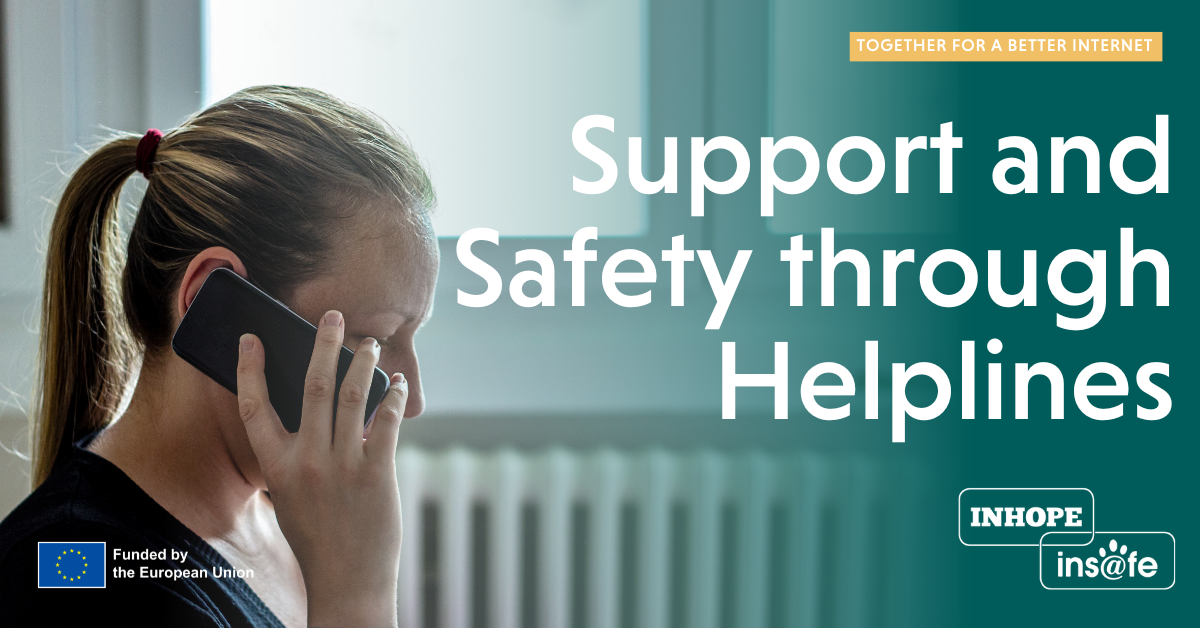Article
Events & Campaigns
Support and Safety through Helplines
Helplines are a critical resource for youth, parents and guardians seeking confidential advice on topics related to digital safety. 58% of hotlines within the INHOPE network, are also part of the Insafe network and operate as Safer Internet Centres. These typically include not only a reporting hotline but a national awareness centre and a helpline to support children, young people and parents in dealing with online safety issues.
Helplines' support services are essential for young people, especially for those without a trusted adult in their life. Last year alone, between October and December the Safer Internet Centre network reported over 18.000 helpline contacts, 61% of which came from teenagers between twelve and eighteen years old. Around 7% of contacts come from children younger than twelve, which highlights how early some children encounter challenges online. Young people in need of support or advice can contact helplines for a variety of reasons related to online safety issues such as harmful content, harmful contact (such as grooming), or harmful conduct (such as cyberbullying or sexting). Contacts relating to cyberbullying or sexting, sextortion and online sexual harassment are the most common across the SIC network.
Accessibility of Helplines
Teaching children how to stay safe and where to seek help online, is just as important as teaching them how to be safe offline. The Better Internet for Kids website offers an overview of various helpline contacts across European countries. But many children won't know to look for those resources online, especially in times of crisis or a state of distress. Our educational systems must provide young people with the necessary information on where and how they can contact their national helplines. Every young person using the internet has to know where to seek support in case a critical situation arises.
Helpline Services for Parents
Young people make up the majority of helpline contacts, but they are not the only ones who can seek support and guidance through a helpline. Research published by the UK Safer Internet Centre revealed that 36% of surveyed parents are unsure where to go should they need support concerning digital safety issues. And the latest helpline trends published by the Insafe network showed that parents accounted for almost a quarter of all helpline contacts between October and December last year. Helplines can provide guidance to parents struggling with topics related to harmful content, conduct and contact but can also assist them in supporting their children when they struggle with similar issues. Furthermore, parents can seek advice on how to appropriately talk to their children about risks online, and teach them how to safely navigate the internet.
Differences Between Helplines and Hotlines
So if both helplines and hotlines deal with online safety issues, what’s the difference between them? Helplines and Hotlines are essential in supporting victims and survivors of abuse. However, they operate very differently and should be contacted for different reasons.
Helplines
- If you are struggling with any issues related to digital safety if you are seeking support and advice on how to deal with challenges encountered online, or if you just need someone to talk to you can contact your national helpline.
- You can contact your national helpline via a variety of means such as telephone, email, web forms, and online chat services, and many offer anonymous services.
- You will be connected with a licensed counsellor who is equipped to offer guidance and support on how to deal with various online safety issues. If you just need somebody to talk to they can listen to your concerns, offer advice, resources or potential solutions, and help you outline action steps for tackling whatever issues you are dealing with.
- If you are experiencing issues related to online safety and need advice or support on how to deal with them don’t hesitate to contact your local helpline
Hotlines
- If you come across material online you suspect to be illegal you should immediately report this content to your national hotline through an online reporting form.
- Trained hotline analysts who receive the report will then assess the material to determine whether the content is illegal.
- If the content identified depicts Child Sexual Abuse Material (CSAM) or other illegal content, the hotline will collaborate with other hotlines within the network, and hosting providers to get the content removed. In certain cases, the material is securely forwarded to law enforcement agencies to facilitate the rapid identification of victims and perpetrators.
- Hotlines are essential in removing harmful and illegal material from the internet but do not offer support, assistance or advice on how to deal with issues related to the material e.g. how to process the exposure to traumatic content.
- If you've come across harmful material online, please report it to your national hotline. Find your local hotline here.
Hotlines and helplines serve different purposes, but both of them are essential in protecting and supporting young people, parents and guardians. May 17th is International Child Helpline Day, on which we celebrate and recognise the importance of national helplines around the world. Everyone, regardless of age or digital literacy should know where and how they can seek support in a time of crisis.
Safer Internet Day would not be possible without the support of the European Union. Funding is provided by the Digital Europe Programme (DIGITAL). Learn more about the European Commission’s new European strategy for a better internet for kids (BIK+) on the EC website.

If you are experiencing issues related to online safety and need advice or support on how to deal with them don’t hesitate to contact your local helpline
'